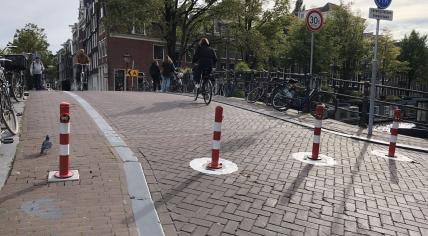
Amsterdam's Canal Belt bridges closed to traffic in 'pole pan' experiment
Bridges on the north and west sides of the Canal Belt in Amsterdam have been closed with dozens of poles since Monday. The experiment, which will last one year, is an initiative of the Amsterdam Centrum district aiming to prevent cut-through traffic in the neighbourhood.
Poles blocking traffic have been placed on bridges over the Brouwersgracht, the canal south of the Haarlemmerbuurt that marks the northern boundary of both the Canal District and the Jordaan neighborhood. The three bridges over the Prinsengracht that connect the Canal District to the northern side of the Jordaan are also blocked to traffic, as are the two bridges over the small Blauwburgwal.
As a consequence, cars, taxis, and trucks can no longer drive through the Canal Belt West, the northern side of the Jordaan neighborhood, and Haarlemmerbuurt districts from north to south and vice versa.
This plan originates from the Centrum district and is the response to a study published in 2021. The study highlighted that local residents face disturbances from frequent cut-through traffic, as drivers often oft for the canals and residential streets instead of the main streets such as Nieuwezijds Voorburgwal, Nassaukade, and Rozengracht.
“The search for a solution to this problem has resulted in a traffic circulation plan, better known as the ‘pole plan’," the municipality stated. With this plan, the municipality explained that it aims to reduce the inconvenience from car traffic in the Canal Belt West, curb cut-through traffic in the northern part of the Jordaan neighborhood, but also diminish traffic over the vulnerable quay walls in the Canal Belt.
The plan was presented in March 2023, and in July, it was decided that the plan would undergo a trial for one year starting in October. Following this period, the district will determine whether to implement it as a permanent measure. The trial will evaluate its impact on traffic and the neighborhoods' quality of life, with insights also drawn from surveys of residents and business owners affected by the plan.
While all streets remain open for cars, travel times might often be extended in many instances. This has already incited frustration among taxi drivers, delivery personnel, and truckers. As AT5 reported on Monday, the blockades mean that many drivers, including locals, sometimes have to undertake significant detours.
Emergency services either have to reroute or manually remove the posts using a key. Het Parool reported on Monday that firefighters spent ten minutes testing removing the posts, which led to some frustration.
A spokesperson for the Amsterdam fire department told NL Times that they have not encountered significant issues with the plan so far. “Of course, removing a pole always causes a slight delay, which we'd prefer to avoid, especially when every second counts,” the spokesperson said. She mentioned that in many other parts of the city, the fire department already deals with poles, so this plan is not a new challenge for them.
According to the fire brigade, the trial can be halted if it leads to significant problems. “We are in close consultation with the municipality, and this is one of the agreements,” the spokesperson remarked.
Amsterdam Alderman Melanie van der Horst for Traffic and Transport expressed on Wednesday "a lot of sympathy" for the firefighters ane said she understands the potential frustrations, NH Nieuws reported. She also pointed out that “constructive discussions” with the fire departement have been ongoing over the past few months. She also said that the firefighters will practice again very soon. "What we are going to do is take another look and practice the entire procedure together."
Van der Horst added that the city would maintain ongoing monitoring of the situation, with the city council receiving updates every three months on the accessibility for emergency services.

